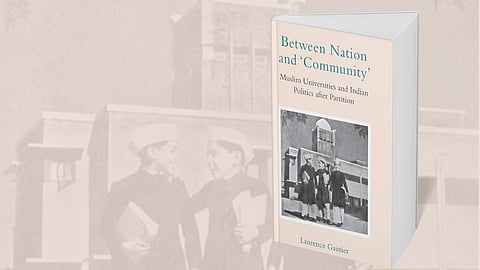

Review of ‘Between Nation and ‘Community’: Muslim Universities and Indian Politics After Partition’, Cambridge University Press, Hardbound, Pages 360, MRP: INR 1,295
THE HISTORY OF PARTITION IS CHECKERED, layered, charged, and packed with complex dynamics. Not a few but many communities and institutions were instrumental in shaping different aspects of post-independence India. From politics to economics to the social and religious spheres, these communities and institutions have often stood at the frontlines; either as intermediaries negotiating between state and society or as core subjects that define the very spirit of the nation, now free from colonial rule. Among all, two institutions stand out for their complex legacies and hold on to be cornerstones in the socio-political life of Indian Muslims: Aligarh Muslim University (‘AMU’) and Jamia Millia Islamia (‘JMI’).
Laurence Gautier, the author of the book, is a historian of modern South Asia where she unpacks this very complexity in Between Nation and ‘Community’. The book focuses on the political and symbolic characters of these two universities in post-Partition India, influenced by their pre-Partition establishments. Deriving from the rich set of archival materials, oral histories, and existing scholarship, including foundational works by David Lelyveld, Barbara Metcalf, and Mushirul Hasan, Gautier explores and puts forth how AMU and JMI have negotiated their institutional identities, Muslim affiliations, and relationship with the Indian state.
The book consists of nine chapters, including the introduction and conclusion, each digging deep into different facets of the two universities. Gautier presents an in-depth and layered exploration from their origin as educational projects to their stand in nation-building, their involvement with minority affairs, and the evolving narratives of empowerment and representation.
The very first chapter, “A laboratory for composite India,” sets the tone by looking at Jamia Millia Islamia’s foundational ideals of composite nationalism, especially around the time of Partition. Jamia, with its proximity to the Indian National Congress and figures like Maulana Azad and Zakir Husain, positioned itself firmly within the secular nationalist camp. Yet, as Gautier notes, this ideological leaning came at a cost. While Jamia gained state patronage and acceptance, it sometimes found itself alienated from large sections of the Muslim populace who viewed it as overly compliant and JMI leaders felt the university wasn’t fully recognised by the State and wasn’t given the same institutional weight as other central universities.
In contrast, the next two chapters together examine the post-Partition repositioning of AMU. Once labelled the “arsenal of Muslim India” due to its close associations with Muslim League and the Pakistan Movement, AMU compelled to reformulate its institutional identity in India as one that was free from the colonial rule. Being an alum of AMU, I find these chapters compelling because Gautier maps how this reformulation was facilitated not only through symbolic and administrative shifts, but also through legal and political struggles, especially with the long-running campaign for AMU’s minority status. Moreover, jointly these chapters show how AMU ventured to preserve its distinctiveness while aligning with the broader national narrative of secularism and inclusion.
Chapters Five, Six, and Seven, forming a thematic triplet, explore how both universities have navigated through the political and social shifts in the post-Nehruvian and liberalisation era. In chapter five, “Resisting minority politics, holding on to composite nationalism,” Gautier focuses on how Jamia Millia Islamia retained its secular-nationalist stance during the communal tensions and rising Hindutva politics of the 1980s and 1990s. In chapter six, “Uplifting backward Muslims,” Gautier examines how the universities gradually began to engage with the discourse around Pasmanda Muslims; while shifting the concern from the elite Muslims to a more inclusive, socially grounded politics. Lastly, in chapter seven, “Bastions of Islam,” the author studies the revival and reinterpretation of Islamic identity within university spaces, not as a retreat into orthodoxy, but often as a counter-narrative to state neglect or majoritarian pressures. Gautier notes that Islam in these universities, in this context, becomes a language of assertion, empowerment, and at times, quiet resistance.
In chapter eight, “Guardians of tradition or actors of change?”, Gautier also pays careful attention to the role of women in both universities. It throws light on the position of Muslim women in AMU and JMI as both cultural custodians and agents of reform. Gautier includes testimonies and examples of women who have navigated these layered expectations while pushing for greater visibility and leadership.
The conclusion of the book brings together these themes by arguing that the histories of AMU and JMI are not just histories of Muslim education but are integral to understanding the larger project of Indian secularism, nationalism, and minority issues. The universities, in Gautier’s telling, are neither passive remains of a forepassed era nor monolithic spaces of identity assertion. The universities are dynamic sites where community and nation, tradition and modernity, continuously cross the path and reconfigure.
For anyone interested in the Muslim identity, assertion, education, or the post-Partition Indian Muslim experience, this work is a valuable, even a necessary, read. However, despite its empirical richness, the book, at times, has oversimplified certain complex dynamics. While drawing the institutional evolution, at certain points it reduces the multifaceted internal politics of these institutes or the intricate socio-political motivations of various actors to more refined narratives, skimming over potential internal tensions or the highly diverse experiences within the broader Muslim community. Moreover, it poses a challenge for the general reader in the book's chronological navigation. Since there are multiple historical events and prominent figures involved, the narrative sometimes drifts between decades and contexts, which makes it slightly difficult for those less acquainted with post-Partition Indian history to fully grasp the precise sequence.